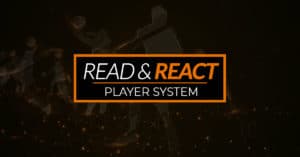Since most of you will be entering the post season this month, I decided to call on the expertise of a friend of mine.
Not only does Spencer Wood have a lot of letters behind his name, he has worked personally with teams in the NBA, ACC, SEC, Big Ten, Big East, and Big Twelve, developing their Mental Skills & Toughness. And, although he lives in America, he maintains a delightful British accent so you know his advice is sound.
Some athletes perform extremely well when they are on an emotional high, while others are at their best keeping their emotions low – you need to know the difference.
Imagine two scales from 1-10.
One of them measures emotional arousal (hype). On this scale a 1 is roughly a comatose pre-game state and a 10 is as hyped as you can get (read: players banging their heads into lockers or giving high fives that sting).
The other scale measures performance with 1 being a lifetime worst performance and 10 being a lifetime best performance.
These two scales are intrinsically connected. But, that connection is not the same for every player. I’ve played with athletes who needed to have a hype number of 3 in order to perform at a 9. I’ve also played with athletes who needed a hype number of 8 to get to that performance 9. And, you guessed it, there are also athletes that are everywhere in between.
A coach’s biggest mistake in pre-game is believing the entire team performs its best at the same hype number. Figure out each players hype number and cater to each one’s needs specifically. And while you’re at it, teach them what their number means so they can help by preparing themselves. Sure, it will take some effort. But, it will absolutely pay off.
Remember: emotional arousal level has nothing to do with intensity. Great emotion and great intensity are not always linked. Not every athlete has to be jacked up, hyped, or highly emotionally aroused to perform at 100% intensity.
Spencer Wood is the author and founder of the Icebox Athlete Mental Skills & Toughness Training System.






